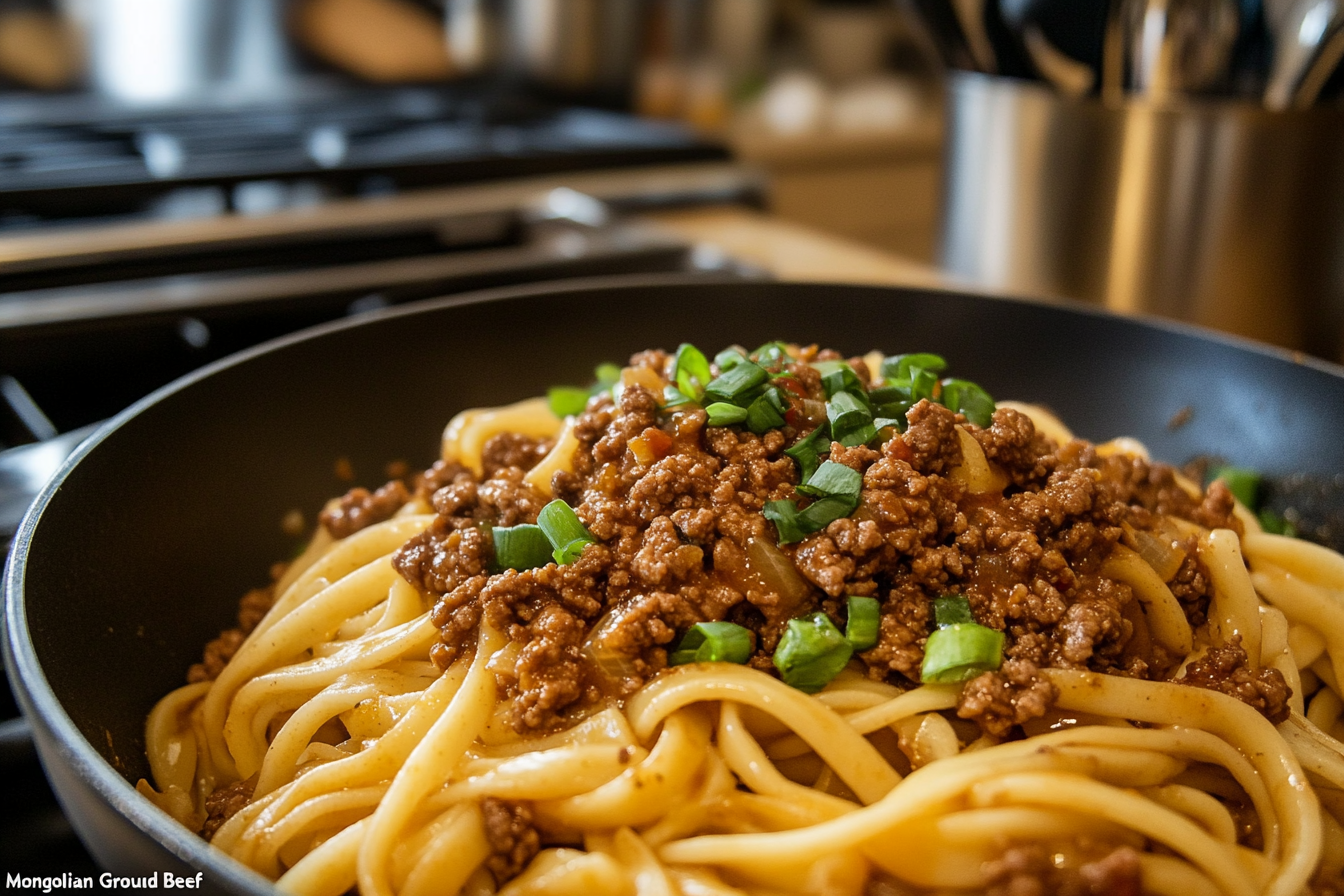Introduction to Mongolian Ground Beef Noodles
mongolian ground beef noodles recipe is a simple yet sophisticated dish that combines the bold, umami flavors of Asian-inspired cuisine with the convenience of quick, budget-friendly ingredients. This recipe is perfect for busy weeknights or casual gatherings, offering a delicious meal that’s easy to prepare and universally loved.
The Popularity of Mongolian-Inspired Dishes
Mongolian cuisine, characterized by its rich and savory flavor profiles, has influenced countless recipes worldwide. The sweet and savory balance of Mongolian-inspired sauces, often featuring soy sauce and brown sugar, has become a fan favorite. This particular dish transforms those flavors into a noodle-based comfort food that’s quick to whip up.
Why Ground Beef Makes This Dish Easy and Affordable
Ground beef is not only versatile but also one of the most cost-effective protein options. It absorbs flavors beautifully, making it an ideal base for the signature Mongolian sauce. The result is a dish that’s both hearty and wallet-friendly, without sacrificing quality or taste.
Essential Ingredients for Mongolian Ground Beef Noodles
To make this dish a success, choosing the right ingredients is key. Each component plays an important role in creating a harmonious balance of flavors and textures.
Noodles: Choosing the Right Type
- Lo Mein Noodles: These are the most authentic option, providing a soft yet chewy texture.
- Spaghetti or Linguine: A readily available alternative that works well in absorbing the sauce.
- Rice Noodles: For a gluten-free version with a slightly lighter texture.
Ground Beef: Lean or Regular for Richer Flavor
- Lean Ground Beef (90/10): Ideal for a lighter dish with minimal grease.
- Regular Ground Beef (80/20): Adds a richer, juicier flavor due to its higher fat content.
Sauce Components: Soy Sauce, Brown Sugar, Garlic, and Ginger
The sauce is the heart of this recipe, combining:
- Soy Sauce: The salty, savory base.
- Brown Sugar: Adds sweetness and a caramelized depth of flavor.
- Garlic and Ginger: Aromatic ingredients that bring warmth and complexity.
Optional Ingredients: Vegetables and Chili Flakes
- Vegetables: Carrots, broccoli, bell peppers, or snap peas for a pop of color and added nutrition.
- Chili Flakes: For those who enjoy a hint of heat, sprinkle these in moderation.
Understanding the Flavor Profile
Creating the perfect balance of sweet, savory, and umami flavors is what sets this dish apart.
Balancing Sweet, Savory, and Umami Flavors
The interplay of salty soy sauce, sweet brown sugar, and umami-packed beef creates a flavor trifecta that’s irresistible. Adjusting the ratio of these elements allows for customization based on personal preference.
The Role of Garlic and Ginger in Asian-Inspired Dishes
Garlic and ginger are essential aromatics in Asian cooking. Garlic lends a pungent, earthy flavor, while ginger provides a spicy, zesty kick that cuts through the richness of the beef.
How to Make Mongolian Ground Beef Noodles
Creating Mongolian Ground Beef Noodles is straightforward and can be completed in less than 30 minutes. The following step-by-step instructions ensure you achieve a dish that’s rich, flavorful, and perfectly balanced.
Step 1: Preparing the Ingredients
Proper preparation is the foundation of a smooth cooking process.
Cooking the Noodles: Al Dente for Best Texture
- Choose your preferred noodle type (lo mein, spaghetti, or rice noodles).
- Cook the noodles in boiling salted water according to package instructions, but reduce the cooking time by 1–2 minutes to achieve an al dente texture. This ensures the noodles remain firm when mixed with the sauce.
- Drain the noodles and toss them with a teaspoon of oil to prevent sticking.
Prepping Vegetables and Aromatics
- Thinly slice or julienne vegetables like carrots, bell peppers, or broccoli florets if you plan to include them.
- Mince 3 cloves of garlic and grate about 1 tablespoon of ginger. These aromatics will form the flavor base of your dish.
Step 2: Cooking the Ground Beef
Properly cooking and seasoning the ground beef is key to a rich, flavorful base.
Browning Ground Beef in a Large Skillet
- Heat 1 tablespoon of vegetable oil in a large skillet or wok over medium-high heat.
- Add 1 pound of ground beef and break it up with a spatula or wooden spoon.
- Cook until the beef is evenly browned and no longer pink.
Draining Excess Fat (If Necessary)
- If you’re using regular ground beef, drain off any excess fat to prevent the dish from becoming greasy.
- Leave a small amount of fat in the skillet for added flavor.
Adding Garlic, Ginger, and Onions for Depth of Flavor
- Push the cooked beef to one side of the skillet and add the minced garlic, grated ginger, and 1 small diced onion.
- Sauté until fragrant, about 1–2 minutes, then mix everything together.
Step 3: Making the Mongolian Sauce
The sauce is what transforms the dish into a bold and flavorful delight.
Combining Soy Sauce, Brown Sugar, and Water
- In a small bowl, whisk together:
- 1/2 cup soy sauce,
- 1/4 cup brown sugar, and
- 1/4 cup water.
- Adjust these amounts to suit your taste preferences (less sugar for a less sweet sauce, or more soy sauce for added saltiness).
Thickening Sauce with Cornstarch Slurry (Optional)
- For a thicker sauce, mix 1 tablespoon of cornstarch with 2 tablespoons of water to create a slurry.
- Stir this mixture into the sauce and simmer for 1–2 minutes until thickened.
Adjusting for Sweetness or Spice to Taste
- Add a pinch of chili flakes or a teaspoon of Sriracha for heat.
- If the sauce is too salty, balance it out with an extra teaspoon of brown sugar.
Step 4: Combining Noodles and Beef
This step brings all the elements of the dish together.
Tossing Cooked Noodles in the Sauce
- Add the cooked noodles to the skillet with the ground beef and sauce.
- Toss gently to ensure the noodles are evenly coated in the flavorful sauce.
Mixing in Ground Beef and Vegetables for Even Coating
- If you’re using vegetables, stir them in now and cook for 2–3 minutes until tender but still crisp.
- Ensure all ingredients are well-mixed and coated in the sauce.
Step 5: Final Touches and Garnishing
Elevate your dish with simple yet impactful garnishes.
Adding Green Onions, Sesame Seeds, or Chili Flakes
- Sprinkle chopped green onions and toasted sesame seeds over the top for added flavor and texture.
- For extra heat, add a dash of chili flakes or a drizzle of chili oil.
Taste Testing and Adjusting Seasonings
- Taste the dish and adjust the seasonings as needed. If it feels too salty, balance with a splash of water or a pinch of sugar.
- Serve immediately for the freshest, most vibrant flavors.
Tips for Perfect Mongolian Ground Beef Noodles
Mastering Mongolian Ground Beef Noodles involves a few tricks to enhance flavor, texture, and presentation. These tips ensure every bite is delicious and satisfying.
Troubleshooting Common Issues
No matter how simple the recipe, challenges can arise. Here’s how to resolve them:
Preventing Noodles from Sticking Together
- Toss cooked noodles with a small amount of oil immediately after draining.
- If you’re prepping noodles in advance, rinse them under cold water to remove excess starch and store them in an airtight container with a drizzle of oil.
Fixing an Overly Salty or Sweet Sauce
- For a too-salty sauce, add more water or a splash of unsalted chicken broth to dilute the intensity.
- For a too-sweet sauce, incorporate a teaspoon of soy sauce or a dash of vinegar to balance the flavors.
Creative Variations
This recipe is highly versatile, allowing for endless customizations. Experiment with these ideas:
Using Ground Turkey or Chicken for a Lighter Version
- Substitute ground turkey or chicken for a leaner, lighter dish that still delivers on flavor.
- Adjust the cooking time as these proteins tend to cook faster than beef.
Adding Crunch with Water Chestnuts or Peanuts
- Incorporate sliced water chestnuts for a subtle crunch that pairs beautifully with the tender noodles.
- Sprinkle crushed peanuts or cashews over the finished dish for added texture and a nutty flavor.
Making It Spicy with Sriracha or Red Pepper Paste
- Mix Sriracha or a teaspoon of Korean red pepper paste (gochujang) into the sauce for a bold, spicy kick.
- Adjust the amount based on your heat tolerance.
Presentation and Serving Ideas
Elevate the dining experience with thoughtful plating and pairing ideas.
Serving in Bowls with Chopsticks for Authentic Appeal
- Dish up the noodles in deep bowls, allowing the sauce to pool at the bottom for easy mixing.
- Serve with chopsticks for an authentic Asian-inspired touch, or pair with a fork for convenience.
Pairing with Steamed Rice or a Light Asian Salad
- Serve the noodles alongside steamed jasmine or basmati rice for a more filling meal.
- Complement the dish with a refreshing Asian cucumber salad or a light sesame slaw to balance the richness of the noodles.
Storage and Meal Prep Tips
Proper storage and reheating techniques are key to enjoying leftovers or preparing in advance.
How to Store Leftovers for Maximum Freshness
- Transfer leftovers to an airtight container and refrigerate for up to 3 days.
- Allow the noodles to cool completely before sealing to prevent condensation, which can make them soggy.
Reheating Techniques to Retain Texture and Flavor
- Reheat in a skillet over medium heat, adding a splash of water or broth to refresh the sauce.
- Microwave leftovers in 30-second intervals, stirring in between to ensure even heating.
Prepping Ingredients for Quick Weeknight Cooking
- Chop vegetables and aromatics in advance and store them in separate containers in the fridge.
- Mix the sauce ahead of time and refrigerate in a jar or airtight container for up to 5 days.

